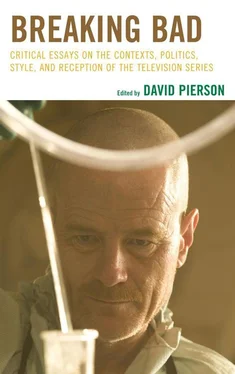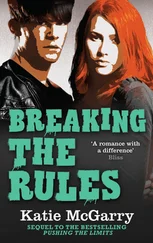Case in point—Although Cameron Diaz grew up speaking Spanish while Jessica Alba did not, it is the darker-complected Alba who is more often cast in Latina roles.
Hank’s quest for social dominance in the DEA office reflects the structuring of the Mexican patriarchal order. In Modernity and the Nation in Mexican Representations of Masculinity (2007), Hector Domínguez-Ruvalcaba notes that Mexican machismo is an outgrowth of the class system in Spanish colonialism. In a nation where skin color and surname no longer carry the meaning they once did under Spanish rule, aggression and dominance are tools of establishing and preserving the social order. As Domínguez-Ruvalcaba states: “Mexican masculinity is an invention of modern colonialism, in which sensualizing means disempowerment” (3). He also notes the homosocial nature of Mexican culture, linking it specifically to machismo. In Mexico, during male-male intercourse the passive recipient is the only partner to be considered homosexual. As actor Gael Garcia Bernal noted while promoting Y tu mamá también (2001) in 2002: “It’s a Mexican idiosyncrasy… you’re more macho if you fuck men” (quoted in de la Mora, 12). Hank uses jokes, taunts, and nicknames to objectify those around them and re-inscribe their place below him in the hierarchy. In so doing he typifies the specific flavor of machismo described by Domínguez-Ruvalcaba and other critics.
Throughout this chapter, I will follow Susan Wendell’s usage of the terms impairment , disability , and handicap . Wendell is in turn borrowing the United Nations definitions, though with a reasonable degree of caution. An impairment is “[a]ny loss or abnormality of psychological, physiological, or anatomical structure or function.” A disability is “[a]ny restriction of lack (resulting from an impairment) of ability to perform an activity in the manner of within the range considered normal for a human being.” Handicap is “[a] disadvantage for a given individual, resulting from an impairment or disability, that limits or prevents the fulfillment of a role that is normal, depending of age, sex, social and cultural factors, for that individual.” See Wendell’s careful and intelligent critique of both the value and limits of the U.N. definitions (Wendell 1996, chap. 1 [especially 13-19]; U.N. 1983). By “visible impairment” I mean any impairment that a non-familiar can become aware of with relatively little or no personal knowledge of that person. Examples of a visible impairment may include paraplegia, cerebral palsy or Down Syndrome. By “invisible impairment” I mean any impairment that a non-familiar could not become aware of by looking at or listening to someone or, perhaps, even working with someone, even for quite some time. Awareness or a person’s invisible impairments requires more personal and intimate knowledge of them. Examples of invisible impairments may include partial or perhaps even severe hearing impairment, Autism Spectrum Condition, or myalgic encephalomyelitis (ME) to name a few.
Wendell (1996) states that, “Stereotypes of disabled people as dependent, morally depraved, superhumanly heroic, asexual, and/or pitiful are still the most common cultural portrayals of people with disabilities” (46).
If disability appears in a novel, it is rarely centrally represented. It is unusual for a main character to be a person with disabilities, although minor characters like Tiny Tim, can be deformed in ways that arouse pity. In the case of Esther Summerson, who is scarred by smallpox, her scars are made virtually to disappear through the agency of love. On the other hand, as sufficient research has shown, more often than not villains tend to be physically abnormal: scarred, deformed, or mutilated (Davis 2010)
Please see also Kent’s chapter on the images of women with disabilities in fiction and drama, Dahl’s article on the role of media in promoting images of disability, Harnett’s article on images of disability in popular television, and Gartner and Joe’s book on images of the disabled.
To make matters worse, Walter’s medical treatments are extremely expensive, hopelessly beyond his family’s financial means. Thus, not only would his death be leaving a wife and two children without a provider, but if he seeks treatment for his (probably terminal) disease, he will leave his family hopelessly destitute, likely homeless.
For example, images of impairment and disability are omitted from most forms of advertising unless the advertisements are for charity advertisements or health service magazines. And those images are more negative than positive. Please see Hevey’s chapter on the enfreakment of photography, and Gartner and Joe’s 1998 book on images of the disabled. Public housing rarely accommodates the needs of disabled and employers underemployed individuals with disabilities (Siebers 2008). Public schools still regularly fail to accommodate the needs of students with disabilities. School districts throughout the United States have renamed special education schools as programs. Once so relabeled, test scores from such programs can be excluded from state assessment tabulations and schools districts can then report that students in their schools are meeting federal mandates. As to whether or not the children in educational programs are flourishing, since those test scores are junked, parents have no way to assess either the progress of their own child or compare the merits of one program with another. Despite the fact that a primary purpose of the No Child Left Behind Education Act was to provide parents with the assessment information necessary to ensure that their disabled child’s education was progressing as optimally as possible, administrators around the country have excluded test scores of children with disabilities to ensure those scores will not harm the financial futures of the schools—the effect, however, is that children with disabilities, and their accomplishments, are effectively being erased ( New York Times as quoted in Siebers 2008, 137). Please also see Silver, Wasserman, and Mahowald’s book on disability, difference and discrimination.
I am speaking in general terms about health and well-being, impairment and disability. How particular conditions and bodily symptoms affect particular people can vary, but I believe persuasive arguments have been made for accepting the claim that Deafness and Autism, say, are conditions that can affect a person’s body and their relationship with the able-bodied community so thoroughly that it makes sense to speak of a person’s Deaf identity or a person’s Autistic identity. Please also see Padden and Humphries chapter on deaf people, Edwards’ chapter on technology and the deaf world, and Staus’s chapter on autism as culture all in Lennard Davis’s The Disability Studies Reader , a 2010 edited collection .
Mike refers to Walt as a ticking time bomb. Walter promises Jesse that there will be no more killing. But Walter’s promise of no more killings is as patently absurd as his proclamation against cancer—bold words, but implausible in running a successful meth business. And there are more dead bodies, a lot of them. Walter orders the deaths of Fring’s men because they could lead the DEA to him. Walter also kills Mike because Mike would not give him the names of those men. As Mike bleeds to death, Walter has an uncharacteristic, albeit brief, moment of regret. He admits that he could have forced Lydia to give him the names of the men. Mike interrupts him asking him to let him die alone. Not only does Walter kill, he kills people he does not even need to kill.
Читать дальше












